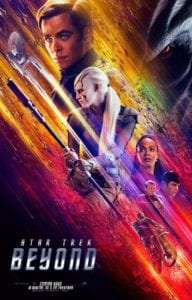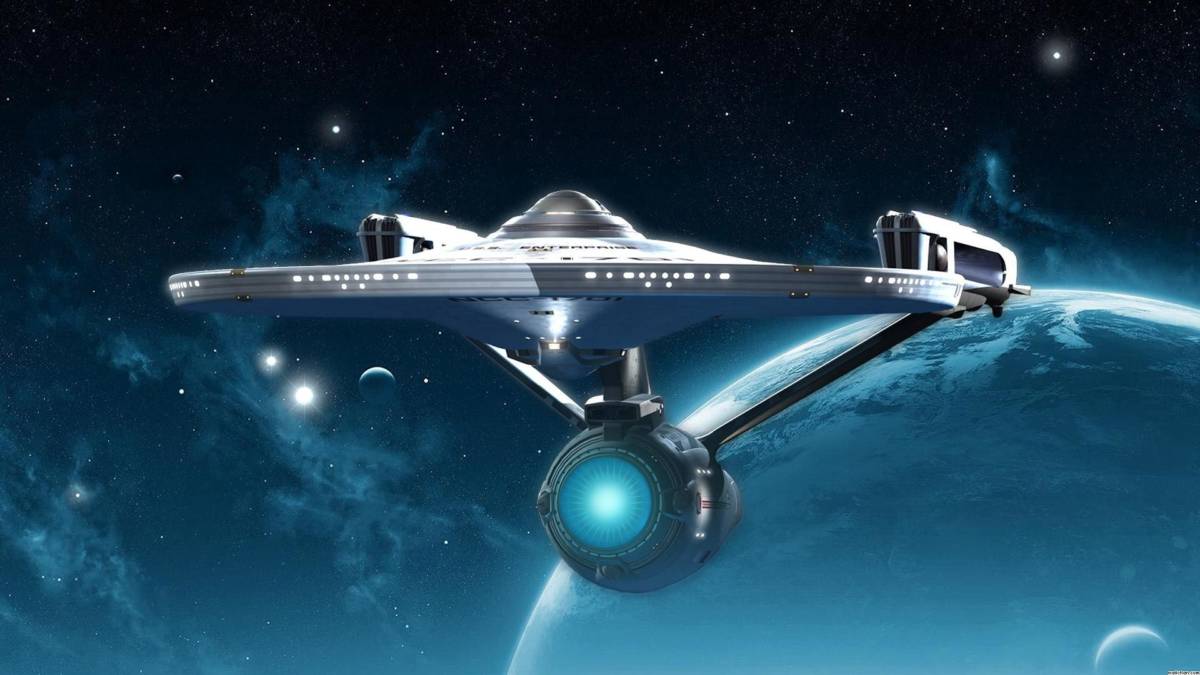Movie Review: “Star Trek Beyond” (PG-13)
![]() “Star Trek” celebrates its 50th anniversary this year, and there’s no better way to usher in this milestone then by welcoming the arrival of a new “Star Trek” movie. Better still, not only is “Star Trek Beyond” a solid entry in the enduring Gene Roddenberry-created series but it also emerges as one of this summer’s most entertaining movies. Credit Justin Lin (who takes over directing duties for J.J. Abrams) and screenwriters Simon Pegg and Doug Jung for injecting a vibe here that could be best described as “vintage Trek.”
“Star Trek” celebrates its 50th anniversary this year, and there’s no better way to usher in this milestone then by welcoming the arrival of a new “Star Trek” movie. Better still, not only is “Star Trek Beyond” a solid entry in the enduring Gene Roddenberry-created series but it also emerges as one of this summer’s most entertaining movies. Credit Justin Lin (who takes over directing duties for J.J. Abrams) and screenwriters Simon Pegg and Doug Jung for injecting a vibe here that could be best described as “vintage Trek.”
As “Star Trek Beyond” opens, the crew of the starship Enterprise are halfway through their five-year mission. Kirk has just engaged a most amusing alien species, and while the outcome is more or less a positive one, this legendary captain begins to question his own self-worth. Eventually, Kirk and his team are brought face to face with a new foe in the form of alien baddie, Krall (played by a magnetic Idris Elba). After a deadly attack, a handful of the crew find themselves stranded on a remote planet where they must use their wits to survive a most dire situation. Meanwhile, Krall looks to hatch a scheme of his own, and if Kirk and crew are unable to come together and put a stop to this fierce enemy’s plan, it could spell certain doom for all that the Federation has worked so hard to build.
 J.J. Abrams’ “Star Trek” reboot was a ton of fun, re-introducing us to the crew of the Enterprise in a new light thanks to a nifty time-travel plot thread. “Star Trek Into Darkness” maintained the sense of cast camaraderie that was so vital to the first picture’s success, but it was bogged down by a script that was far too insistent on recklessly dipping into original “Star Trek” canon.
J.J. Abrams’ “Star Trek” reboot was a ton of fun, re-introducing us to the crew of the Enterprise in a new light thanks to a nifty time-travel plot thread. “Star Trek Into Darkness” maintained the sense of cast camaraderie that was so vital to the first picture’s success, but it was bogged down by a script that was far too insistent on recklessly dipping into original “Star Trek” canon.
“Beyond,” as energetically written by Pegg and Jung, is the most “trekky” of the new “Star Trek” films. There’s a sense of fun to the proceedings to be sure, but the themes of family, unity, and honor are really at the forefront here, and it’s these themes that most embody Roddenberry’s vision for “Star Trek.”
Lin has had plenty of experience directing multi-cultural ensembles (see his entries in the “Fast and Furious” franchise). Therefore, his being brought aboard this series really made sense even if on paper it might not have seemed like a very good idea. After all, the “Fast and Furious” movies play it fast, lose, and goofy whereas the best of “Star Trek,” while fun, tends to be more thought-provoking in nature. As it turns out, Lin is clearly up to the challenge here, mounting a handful of truly spectacular set pieces but never allowing these sequences to trump character.
Speaking of character, the choice to break up members of the crew into teams in this picture is a smart one, because it gives “Star Trek Beyond” the opportunity to sink its teeth into specific character dynamics. This is particularly true of a subplot involving Spock and McCoy. Spock (affectionately played by Zachary Quinto) is grappling with the idea of possibly leaving his position aboard the Enterprise after an incident has him reexamining his heritage, but his current predicament has him questioning whether or not that might be the best choice. Meanwhile, McCoy (played wonderfully by Karl Urban) proves to be Spock’s best friend after a severe injury has the Vulcan leaning on the good doctor pretty heavily. There’s a playful rapport between Spock and Bones here, and it’s about time that these reboots explored this dynamic.
All your favorite “Star Trek” characters are given their moments to shine in “Beyond”: Uhura (Zoe Saldana), Sulu (Jon Cho), Chekov (the late Anton Yelchin), Scotty (Pegg), etc. As great as the ensemble is, it’s Pine who holds it all together. He brings a swagger and vulnerability to this incarnation of Kirk, and while there’s a glimmer of Shatner-era Kirk in this portrayal of the character, Pine confidently makes this role his own. He’s a terrific actor, and this might be his strongest work in the “Star Trek” series thus far.
Elba brings menace in spades, and a scene in which Krall commits a truly evil act would have you believe that this would be a “Star Trek” villain for the ages. Sadly, though, the character as written comes up a tad short. On the other end of the spectrum, new to the series is Sophia Boutella who proves to be fiercely independent as Jaylah. She’s spunky and tough, and her interactions with Scotty are particularly memorable.
There are few missteps in “Star Trek Beyond.” The effects work in the opening sequence had me concerned that this film would be far too cartoony. Likewise, a sequence involving a motorcycle felt like it would be more at home in a “Mad Max” movie. Thankfully, these moments are minimal and don’t hurt the overall tenor of the movie.
For all its grand adventure and deep space exploration, “Star Trek Beyond” is at its most basic level a story about family, and that really comes through. There are genuine thrills and real drama here, but the film is far more hopeful than cynical, and it’s always punctuated by a sense of fun. Even moments that feel like they’d be dead in the water work surprisingly well. Look no further then a call back to Kirk’s favorite Beastie Boys track. Yes, “Sabotage” is back, but I’ll be damned if the song doesn’t work in this picture. In the first film, the tune sort of made me cringe. Here, it made me smile.
In terms of sheer energy, “Star Trek Beyond” isn’t quite at the same level as Abrams’ 2009 reboot, but it’s certainly more in tune with the overall spirit of “Star Trek” and it’s considerably stronger than several other entries in this age old franchise. At the very least, Lin and crew have fashioned a grand space adventure that’s worthy of its timely Star Trek 50th anniversary release. Here’s hoping that potential future voyages of the starship Enterprise continue to boldly go where no previous “Star Trek” movie has gone before.







